Guide to Augusta National
from the Experts in Golf Holidays
⏱ 8 min read
from the Experts in Golf Holidays
⏱ 8 min read
As the only major championship to be staged at the same course year after, The Masters and its home at Augusta National have a wonderfully nostalgic and familiar feel among golf fans. And yet, one of the most common things we hear from our clients when they return from their dream golf holidays to Augusta is that the course is actually like nothing you could ever imagine.
Everything is bigger and bolder, the sheer scale of the slopes take first timers completely by surprise, and the course is prepared to such a level of perfection that sometimes it just doesn’t seem like it can be real.
With all that in mind, we thought we’d take an in depth look at each hole on the world’s most famous golf course; home of golf’s greatest event, Augusta National.
| Front 9 | Back 9 | |||
|---|---|---|---|---|
| 1 - | Tea Olive | 10 - | Camellia | |
| 2 - | Pink Dogwood | 11 - | White Dogwood | |
| 3 - | Flowering Peach | 12 - | Golden Bell | |
| 4 - | Flowering Crab Apple | 13 - | Azalea | |
| 5 - | Magnolia | 14 - | Chinese Fir | |
| 6 - | Juniper | 15 - | Firethron | |
| 7 - | Pampas | 16 - | Redbud | |
| 8 - | Yellow Jasmine | 17 - | Nandina | |
| 9 - | Carolina Cherry | 18 - | Holly |
Tea Olive is not the easiest hole to start on by any stretch of the imagination. From the tee, a slight dog-leg from left to right means driving has to be accurate as the fairway is not the widest. The big-hitters will have the advantage on this as a massive bunker on the right side of the fairway means they will need to hit it over 300-yards to carry the trap. Hit the drive safely on the centre of the fairway and they’ll be left with a very difficult second shot to the green.
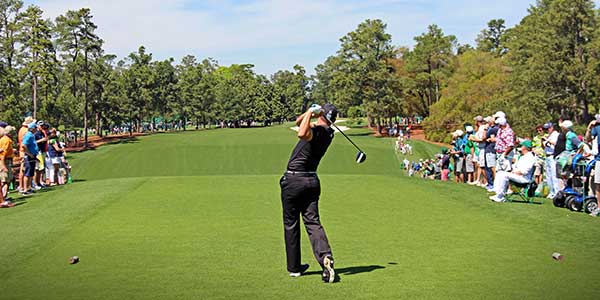
The elevated green is at an angle with another inviting bunker to the left. Be too aggressive, and a double bogey is certainly on the cards. The different levels on the green makes it very difficult to get the ball close to the hole meaning par is always a solid start at Augusta.
Quick Facts about the 1st at Augusta National
• Home of the Honorary Opening Tee Shot where Jack Nicklaus & Gary Player will strike their tee shots to mark the start of the tournament on Thursday
• The hole is historically the 6th hardest on the course (ranked 7 last year)
• 2019 Masters Champion Tiger Woods managed 4 pars on his way to claiming his 5th Green Jacket
• The hole originally measured 400 yards in 1974 and is a more amiable 365 yards off the members tee
After a difficult opening first hole, players will look at the second as a potential birdie on the scorecard. The first of four par 5’s, Pink Dogwood is a dogleg to the left which sweeps down an enormous hill; the first sign of Augusta National’s dramatic slopes.
Easily reachable in two for the big hitters, players will look to avoid a fairway bunker on the right, which is 300 yards down the fairway. Moving the tee shot from right to left is ideal, but overdo it, and a large copse of trees will make going for the green in two very unlikely.

The green features a narrow entrance that is well guarded by two enormous bunkers. Sloping sharply from left to right, players will look to take advantage when they can, like when the far right Sunday pin position is in place. Think Louis Oosthuizen 2012 and you’ll know what we mean.
Quick Facts about the 2nd at Augusta National
• The hole was the easiest hole in last years Masters scoring
• Originally the green was guarded by just the right bunker. The left was added in 1946 and the right was reduced in size in 1966
• In 2023, there were 121 pars, 121 birdies, 23 bogeys and 6 double bogeys or more on this hole
• In 2012, Louis Oosthuizen got the first albatross on this hole in Masters history with a four-iron from 253 yards.
Flowering Peach is a classic par 4 and the shortest at Augusta by 90 yards. Standing on the tee, four bunkers are situated on the left of the fairway meaning the majority of players will take a shorter club to lay up before the traps and hit an awkward wedge shot into the green which is where further danger lies.
Miss the green to the left and there lies the fifth and final bunker of the hole but with the dancefloor sloping heavily from right-to-left, the players will be hoping to use the slope and roll the ball towards the hole depending on the pin position.
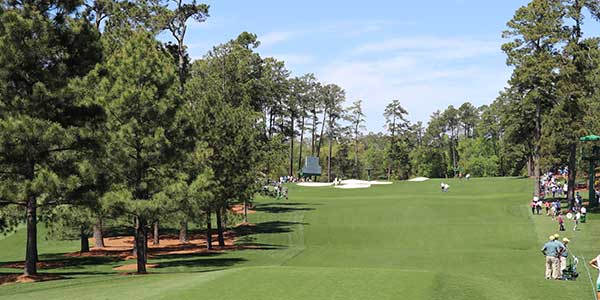
On the Sunday, the pin is usually in an extremely difficult position meaning pinpoint accuracy is required to make a birdie. As history shows it is much better to go long rather than short as the ball will fall back down the slope to leave a 15-20 yard pitch shot onto the green.
Quick Facts about the 3rd at Augusta National
• With a historical average of 4.08 the 3rd is the 14th hardest hole at Augusta
• It has been changed less than any other hole on the course
• Tiger Woods played this hole to -1 in 2019
In 2003, veteran Jeff Maggert was in contention until he arrived at the third. After finding the fairway bunker, his second shot was up against the lip. The ball rebounded back and hit him which resulted in a two-shot penalty to end his hopes of the green jacket.
The first par 3 on the course is the longest of the short holes at Augusta and certainly one of the toughest. Measuring 240 yards, golfers will take a long iron or even a fairway wood depending on where the pin position is. The green, which was formerly shaped as a boomerang, is always a narrow target, with a deep bunker on the right and a smaller one on the left.

The green features a big slope from back-to-front so pins towards the front of the green are more accessible as the players can land their ball behind the hole and use the slope to bring it back. Unpredictable swirling winds are also known to play havoc so club selection is key.
As we have seen down the years, the players will walk off the green with a sigh of relief if they manage to get a par on this hole. A loose shot and a double bogey is easily on the cards.
Quick Facts about the 4th at Augusta National
• The hole has been extended by 35-yards between 2006-07
• Historically this is the third hardest hole at Augusta (ranked 5 last year)
• The hole was once named Palm Hole because the only palm tree on the course stands to the right of this fairway
❝The fourth hole has given me more trouble down the years than any other par 3 on the golf course.❞
Jack Nicklaus - 6 time Masters Champion
The fifth is a very underrated hole at Augusta. Ahead of the 2007 Masters, the tee was moved back and the two fairway bunkers were extended towards the green meaning a carry of 315 yards is needed to clear the traps. It may be the reason why in 2010, it was the hardest hole on the course for the week. An uphill tee shot with a dogleg left, most players will take a 3-wood to drop clear of the inviting fairway bunkers.
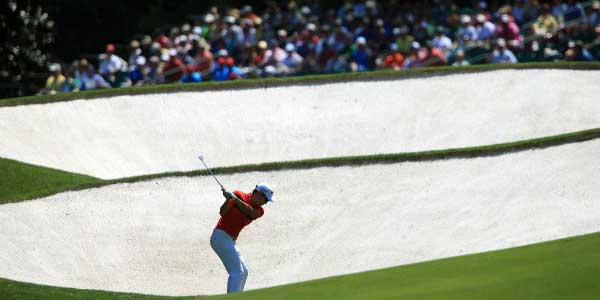
But that leaves a dangerous second shot with a notoriously difficult green. A false front runs about 15 yards into the front of the green meaning the iron shot requires precision. Most players have difficulty landing the ball on the right level leading to challenging two-putts. The players will also have to contend with a severe right-to-left slope on the green and a bunker to pick up any shots that are overhit.
It may not look the hardest but looks can be deceiving.
Quick Facts about the 5th at Augusta National
• In 2023 it was the hardest hole on the course
• The hole was inspired by the legendary Road Hole at St Andrews
• This used to be one of the least known holes on the course after television coverage of the tournament rarely showed players on this hole
An unusual hole where the tee and green are elevated above the rest of the hole. The main danger here is the unpredictable, tiered green. On the right hand side, the green is raised about five feet proving extremely difficult to get the ball on the same level as the flag.
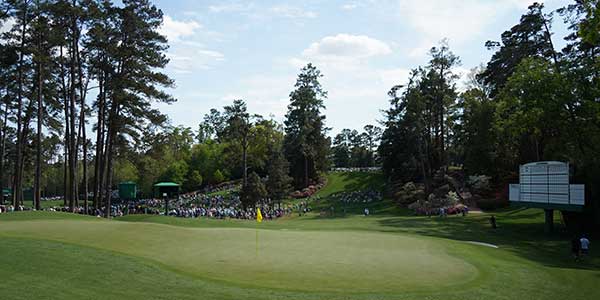
A large gaping bunker at the front of the green will collect any shots that fall short. In essence, anywhere but the green spells real danger. Going long leaves a horrible pitch back up the steep bank but there has been a few holes-in-one here down the years including Jamie Donaldson in 2013. Club choice and conviction is key here and birdie opportunities are available with a solid tee shot.
Quick Facts about the 6th at Augusta National
• Historically, the sixth is the 13th hardest hole at Augusta (ranked 10 in 2023)
• In the 1930s, the green was fronted by a stream and in the 1950s by a pond but they were both removed in 1959
• Five players have had holes-in-one on the sixth since Leland Gibson in 1954
After a number of relatively open holes, the 7th is narrow and compact requiring a dead straight drive to find the fairway and avoid the two lines of trees on either side.
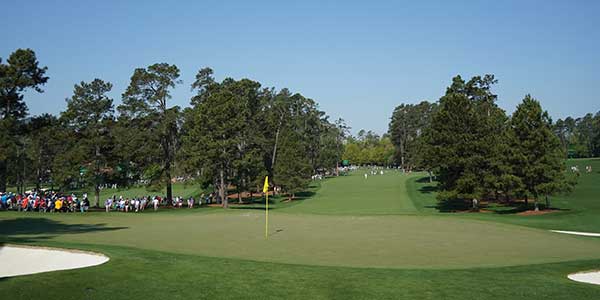
The green is protected by five bunkers – three at the front and two at the back so precision and distance is vitally important. The players have a decision whether to blast a driver and leave themselves with a shorter chip or play safer with a three-wood and make sure they hit that fairway. Anywhere else and a bogey is almost certainly on the cards.
Quick Facts about the 7th at Augusta National
• The 7th is historically the tenth hardest hole at Augusta (rankd 6 last year)
• Since 2002, the hole has been extended by around 85 yards
• Charles Coody holds the record for the most shots taken on this hole – a triple-bogey in 1972
A long, winding par 5 that drifts from left to right and back to the left again, the 8th is the second par 5 on the front 9 and the players will see this as another opportunity for a birdie. From the tee, avoiding the massive bunkers on the right is key to being able to take on the green in 2.
Such is the severity of the slope back up to the high part of the property, players will essentially play their second shots blind, with even the longer hitters needing to reach for a fairway wood in most cases to reach.
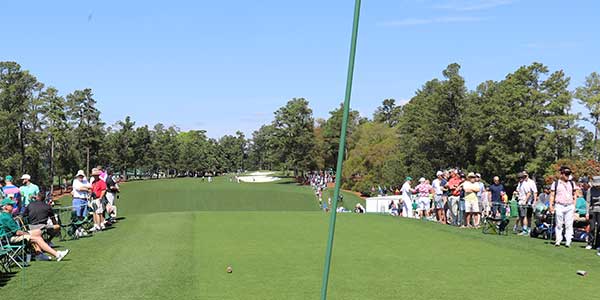
Unusually, there aren’t any greenside bunkers on the 8th, but dramatic mounding ensure short game shots are still a challenge, and can also be used by Augusta veterans to feed the ball to particular pins, especially those located in the back left portion of the green.
Quick Facts about the 8th at Augusta National
• Last year, the 8th was the second easiest hole at Augusta
• The greenside mounds were removed in 1956 to improve views for spectators but were restored in 1979
• Bruce Devlin scored the second double-eagle in Masters history on this hole in 1967
Jack Nicklaus was in contention of winning the 1970 Masters until he played this hole. After hooking his approach shot into the woods, Nicklaus lost his ball. A stroke and distance penalty followed before three-putting for a triple bogey eight to end his hopes of claiming the green jacket.
The final hole on the front nine is Carolina Cherry and like most holes at Augusta, it is more difficult than it looks on the television. From the tee, the ideal shot is to aim further to the right of the fairway to ensure a clear second shot onto the green which is where the trouble begins.
You’ll hear from anyone who has been to Augusta in person that it’s hard to imagine the severity of the slopes on the course, and the climb to the 9th green is one of the steepest. The green slopes from back to front more severely than it appears on TV, so depending on the pin position, approach shots coming up short could be in real trouble as they turn and run back off the front of the green.
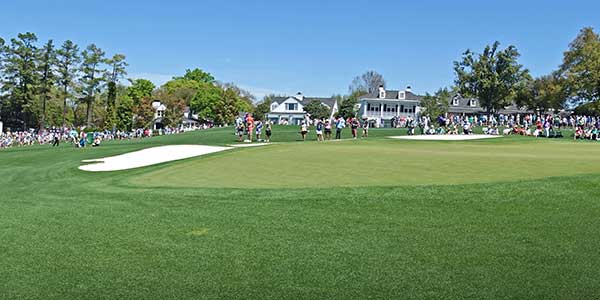
Even the best players need some luck to score well on the ninth.
Quick Facts about the 9th at Augusta National
• The ninth hole ranks as the 12th hardest at Augusta
• 41 birdies were made on the ninth in 2019 compared to 70 bogeys
• The lowest average scoring year on this hole came in 1968
In 1996, Greg Norman approached this hole in good shape of winning the Masters on the Sunday. His second shot looked good, until it spun back down the green and onto the fairway. It was the start of his famous six shot collapse that allowed Nick Faldo to win the Green Jacket.
The 10th is one of the most dramatic holes at Augusta National, dropping some 100 feet from the tee down to the green below. The fairway sweeps from right to left so while the likes of Rory and DJ will be looking to hit a draw, Phil Mickelson and his fellow lefties require a fade to take the most advantage of the slopes which can add significant yardage to a tee shot.
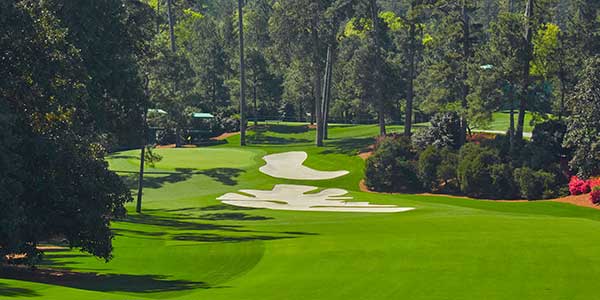
Truth be told, the bunker the stretches up the middle of the fairway some distance from the front of the green isn’t in play, but it does mess with players depth perception. Like many greens at Augusta, the 10th falls away at the front and with a bunker guarding the front right portion of the green, approach shots will have to be deadly accurate, particularly with a front pin position.
Quick Facts about the 10th at Augusta National
• The 10th used to be the first, until the holes were reversed in 1935
• Historically, the 10th is the hardest hole in Masters history
• The green used to be on the right of the fairway bunker until it was moved in 1937 making the hole extremely demanding
In 2012, Bubba Watson pulled off one of the greatest shots in recent Masters history on this hole. After being deep in the trees on the right of the fairway, he hooked a 40-yard wedge that landed on the green and 10-feet away from the hole to win the Masters.
White Dogwood marks the start of Amen corner, but not from the tee…more on that in a minute! On the longest par 4 on the course, players will simply look to gain as much yardage as possible off the tee, avoiding at all costs a big miss to the left. Plenty will bail out to the right and face tree trouble but once in position to hit an approach shot into the green, you’re officially now in Amen Corner which actually includes the approach into 11, the par 3 12th, and the tee shot up the 13th.
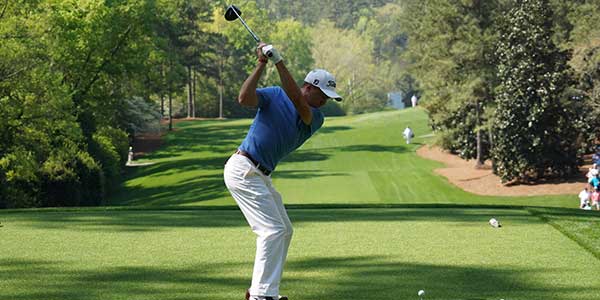
The approach at 11 is fraught with danger, with a huge drop off to the right of the green and a water hazard lurking left which both make getting out of here with par a tricky proposition if you miss the green.
Unless your name’s Larry Mize of course...
Quick Facts about the 11th at Augusta National
• The 11th ranks as the 2nd hardest hole on the golf course (ranked 3rd in 2023)
• Prior to 1950, Rae’s creek ran in front of this green before it was replaced by the lake
• 2019 Masters Champion Tiger Woods made three pars and a birdie on this hole
The 11th will be remembered for one of the most famous shots in the tournament’s history. In 1987, Larry Mize chipped in from off the green in a playoff against Greg Norman to claim the green jacket. Before that, he had won just one PGA Tour event.
Measured at just 155-yards, Golden Bell is one of the shortest holes in tournament golf but it is one of the most difficult. Swirling winds make club selection an extremely tough challenge and players will need to hit over the dreaded Rae’s Creek. One bunker guards the front of the green whilst two others will collect any shot that goes over the back. Distance and accuracy has never been more important and many have seen their round ruined on this hole.
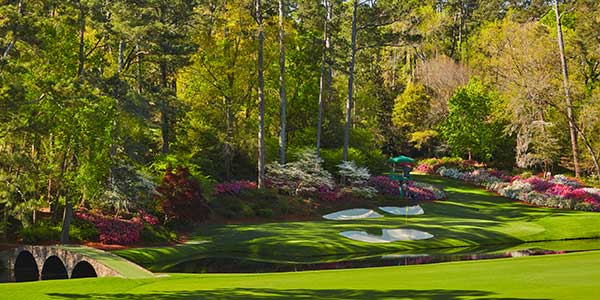
The route here is to hit the centre of the green but it is not as simple as it sounds. The landing zone is small, barely six yards from front-to-back in some places and it increases in difficulty the further right the pin is. Expect it to be over to the right on the Sunday and expect a few blobs on the scorecard.
Quick Facts about the 12th at Augusta National
• Historically, it is the 4th hardest hole on the course (ranked 12 in 2023)
• A record number of shots at Augusta was made on this hole – 13 by Tom Weiskopf in 1980
• The bridge leading to the green is named after the great Ben Hogan – Hogan Bridge
• Jack Nicklaus once described this as the most difficult par 3 in tournament golf
A hole that players will look to for birdies and even a potential eagle, although one slight error and a six will quickly be on the scorecard. From the tee, the drive requires a hefty draw around the trees as the fairway slopes from right-to-left but draw it too much, and the ball could find the creek which runs down the left of the fairway. Find the fairway and it’s a full on green light, with plenty of players in the field needing only a mid iron to reach in 2.
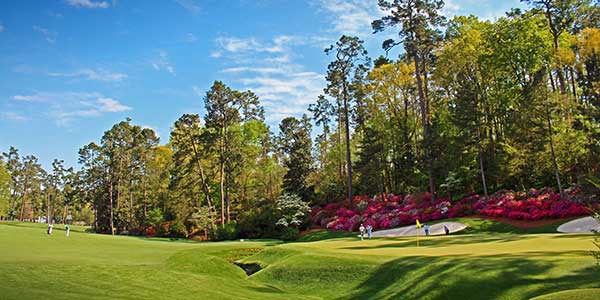
With the ball above the feet on the second shot, it could prove difficult. Players will have the decision whether to go for it or lay short of Rae’s Creek running across the front of the green. Four bunkers lay behind the hole and the three terraced green offers a solid read with the putter in hands to see the ball drop.
Quick Facts about the 13th at Augusta National
• Historically, the 13th is the easiest hole on the course (ranked 4th easiest in 2023)
• 2019 winner Tiger Woods played this hole to -3
• Golfers have to cross Byron Nelson’s bridge to make their way up the 13th. It was dedicated to Byron Nelson in 1958 after his come-back win at the 1937 Masters where he made up six strokes on holes 12 and 13
Phil Mickelson pulled off one of the greatest shots seen in recent Masters history here in 2010. After pulling his tee shot straight into the trees, the left hander pulled out a six-iron and perfectly struck his ball off the pinestraw, through the trees and five feet from the cup.
The 14th is the only hole on the course without a single bunker but other dangers await. The fairway slopes severely from left-to-right but with a dogleg left up the hill, the ideal tee shot would be to draw it round and let the ball roll down the slope.
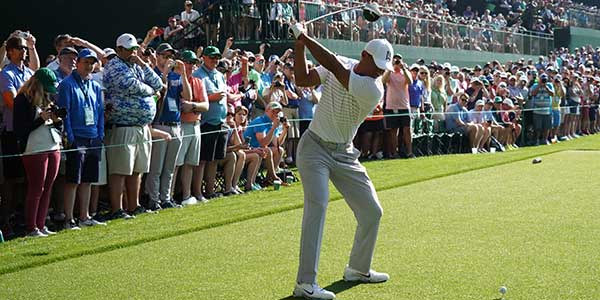
The second shot with the ball below the feet is where things can get difficult. The danger on the 14th is the green and like the fairway, it has a heavy tilt from left-to-right meaning players will aim for the TV towers to the right and draw the ball back into the green. At the front of the short stuff lies a ramp to play more havoc. Any shots that fall short will roll back off the green and onto the fairway.
Pin point accuracy is needed otherwise a three-putt is a distinct possibility.
Quick Facts about the 14th at Augusta National
• There used to be a fairway bunker until it was removed in 1952
• Historically, this is the 8th hardest hole in Masters’ history
• There were 25 birdies, 184 pars and 64 bogeys on this hole last year
Fred Couples had a 4-foot putt for birdie here in 2006 to move within one of leader Phil Mickelson but ended up three-putting for a bogey and tied for third.
The 15th is a hole that provides some light relief and a chance to score a birdie or better. It is one of the most inviting tee shots at Augusta with a wide fairway allowing players to open their shoulders and cannon the ball down the middle.

A bunch of trees on the left encroach the fairway so any shots down that side could be blocked off, but with a big tee shot, the green is definitely accessible in two, however with a pond lying short of the green and a sharp slope back towards the water on the very front edge of the putting surface, distance is vital. Go long and the players will be left with a horrible chip back towards the pond.
Quick Facts about the 15th at Augusta National
• Historically, the 15th is the 2nd easiest hole in Masters history (3rd in 2023)
• In 1935, the 15th green had no bunker as Bobby Jones firmly believed that all par fives on the course should be within reach of two shots for better players
• This hole was made famous by Gene Sarazen in 1935 and his shot which went in for two from 235 yards was named as “the shot that was heard around the world”
The 16th has seen many a magical moment down the years, but none more so than a pair of shots hit by a certain Tiger Woods.

His dramatic chip in against Chris Dimarco in 2005 would’ve been warmly welcomed by the Nike marketing department, as the famous swoosh famously hung on the lip before eventually rolling over and dropping in for an unlikely 2, while a near miss of a hole in one that lead to a tap in birdie in 2019 was the moment Woods firmly took control of the tournament on his way to his emotional 15th major win.
Quick Facts about the 16th at Augusta National
• Historically, it is the 11th hardest hole at the Masters
• There were 51 birdies on this hole in 2023 compared to just 35 bogeys
• There have been 24 holes-in-one on the 16th, more than any other hole at the Masters
In 2005, the world witnessed one of the finest shots by the worlds greatest player at the time. Tiger Woods had a one-shot lead over Chris DiMarco when he missed the green long. He chipped the ball onto the green, up the slope and agonisingly watched it trickle back towards the flag. Time seemed to standstill as the ball stopped on the lip before dropping in to a massive cheer. Words struggle to do it justice.
The penultimate hole at Augusta, the 17th requires the players to hit their tee shots right down the middle. A narrow fairway of around 30-yards wide is guarded by trees on both sides but the players will not have to contend with Ike’s tree after it was sadly removed last year due to storm damage.
Hit it well and they will be left with a short approach shot onto a notoriously difficult green. One bunker will sweep up anything that goes short whilst another will catch anything that misses to the left. Swirling, unpredictable winds can also play havoc and club selection will not be an easy task.
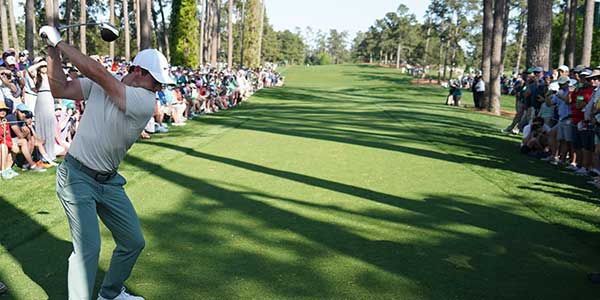
The green itself slopes in all directions and a pin position towards the back, where it usually is on Sunday, means players will do everything in their power not to go long. Only a handful get it down in two if they go over the back.
Quick Facts about the 17th at Augusta National
• Historically, the 17th is the ninth hardest hole at Augusta (4th in 2023)
• The fairway used to be around double the width it is now
• The Eisenhower tree, which had to be removed, was named after the 34th president who asked for it to be cut down because he kept hitting it into the tree
In 1986, Jack Nicklaus holed a birdie putt on this hole which became one of the most iconic images in Masters history. He went onto become the oldest winner of the tournament at 46-years-old.
One of the most visually intimidating tee shots in golf, the alley of trees that line the 18th at Augusta seem impossibly narrow to navigate, but a well struck driver or fairway wood will bypass them fairly quickly.
The players main concern will be to keep their tee shot far enough left to avoid any overhanging tree issues they might face with the approach shot, but not so far left that the bunkers come into play. Moving the ball left to right helps, but the degree of accuracy here is high, to say the least.
Once safely in the fairway, the hole climbs to the green almost as sharply as the 10th drops, to a two tiered green protected by a pair of bunkers; one short and left and another to the right.
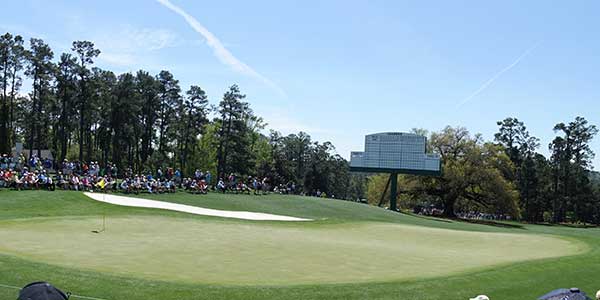
In 1988, Sandy Lyle needed at least a birdie to win The Masters. As he arrived at the 18th, he found the fairway bunkers on the left. With European fans fearing the worst, Lyle pulled off one of golf’s greatest shots which landed past the flag but rolled back towards the pin. He sunk the birdie putt and Europe had a new Masters winner.
Quick Facts about the 18th at Augusta National
• Historically, the 18th is the seventh hardest hole at Augusta
• Last years winner Jon Rahm played this hole in level par
• Even in it’s original form, the 18th had two distinct tiers. The surrounds have been contoured to improve sight lines for spectators
Your Golf Travel have organised trips for thousands of golfers to attend this event and have a range of different experiences to watch the event unfold in Georgia.
Why choose Your Golf Travel?
✅ ABTOT & ATOL Protected
✅ 15 Years Experience
✅ Over 5,000 Clients Travelled
✅ Full Event Management
✅ Hospitality & Entertainment
✅ Flight Upgrades to Premium, Business & First Class available
9-12 APRIL 2026
Augusta National
Georgia, USA